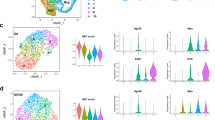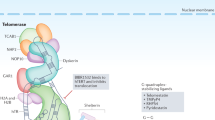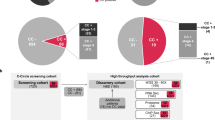Abstract
Telomere biology is frequently associated with disease evolution in human cancer and dysfunctional telomeres have been demonstrated to contribute to genetic instability. In BCR-ABL+ chronic myeloid leukemia (CML), accelerated telomere shortening has been shown to correlate with leukemia progression, risk score and response to treatment. Here, we demonstrate that proliferation of murine CML-like bone marrow cells strongly depends on telomere maintenance. CML-like cells of telomerase knockout mice with critically short telomeres (CML-iG4) are growth retarded and proliferation is terminally stalled by a robust senescent cell cycle arrest. In sharp contrast, CML-like cells with pre-shortened, but not critically short telomere lengths (CML-G2) grew most rapidly and were found to express a specific ‘telomere-associated secretory phenotype’, comprising secretion of chemokines, interleukins and other growth factors, thereby potentiating oncogene-driven growth. Moreover, conditioned supernatant of CML-G2 cells markedly enhanced proliferation of CML-WT and pre-senescent CML-iG4 cells. Strikingly, a similar inflammatory mRNA expression pattern was found with disease progression from chronic phase to accelerated phase in CML patients. These findings demonstrate that telomere-induced senescence needs to be bypassed by leukemic cells in order to progress to blast crisis and provide a novel mechanism by which telomere shortening may contribute to disease evolution in CML.
This is a preview of subscription content, access via your institution
Access options
Subscribe to this journal
Receive 12 print issues and online access
$259.00 per year
only $21.58 per issue
Buy this article
- Purchase on Springer Link
- Instant access to full article PDF
Prices may be subject to local taxes which are calculated during checkout








Similar content being viewed by others
References
Blasco MA . Telomeres and human disease: ageing, cancer and beyond. Nat Rev Genet 2005; 6: 611–622.
Harley CB, Futcher AB, Greider CW . Telomeres shorten during ageing of human fibroblasts. Nature 1990; 345: 458–460.
Braig M, Lee S, Loddenkemper C, Rudolph C, Peters AH, Schlegelberger B et al. Oncogene-induced senescence as an initial barrier in lymphoma development. Nature 2005; 436: 660–665.
Braig M, Schmitt CA . Oncogene-induced senescence: putting the brakes on tumor development. Cancer Res 2006; 66: 2881–2884.
Feldser DM, Greider CW . Short telomeres limit tumor progression in vivo by inducing senescence. Cancer Cell 2007; 11: 461–469.
Suram A, Kaplunov J, Patel PL, Ruan H, Cerutti A, Boccardi V et al. Oncogene-induced telomere dysfunction enforces cellular senescence in human cancer precursor lesions. EMBO J 2012; 31: 2839–2851.
Brummendorf TH, Balabanov S . Telomere length dynamics in normal hematopoiesis and in disease states characterized by increased stem cell turnover. Leukemia 2006; 20: 1706–1716.
Gunes C, Rudolph KL . The role of telomeres in stem cells and cancer. Cell 2013; 152: 390–393.
Perrotti D, Jamieson C, Goldman J, Skorski T . Chronic myeloid leukemia: mechanisms of blastic transformation. J Clin Invest 2010; 120: 2254–2264.
Bolton-Gillespie E, Schemionek M, Klein HU, Flis S, Hoser G, Lange T et al. Genomic instability may originate from imatinib-refractory chronic myeloid leukemia stem cells. Blood 2013; 121: 4175–4183.
Brummendorf TH, Holyoake TL, Rufer N, Barnett MJ, Schulzer M, Eaves CJ et al. Prognostic implications of differences in telomere length between normal and malignant cells from patients with chronic myeloid leukemia measured by flow cytometry. Blood 2000; 95: 1883–1890.
Drummond M, Lennard A, Brummendorf T, Holyoake T . Telomere shortening correlates with prognostic score at diagnosis and proceeds rapidly during progression of chronic myeloid leukemia. Leuk Lymphoma 2004; 45: 1775–1781.
Broccoli D, Young JW, de Lange T . Telomerase activity in normal and malignant hematopoietic cells. Proc Natl Acad Sci USA 1995; 92: 9082–9086.
Brummendorf TH, Rufer N, Holyoake TL, Maciejewski J, Barnett MJ, Eaves CJ et al. Telomere length dynamics in normal individuals and in patients with hematopoietic stem cell-associated disorders. Ann N Y Acad Sci 2001; 938: 293–303, discussion 303-294.
Melo JV, Barnes DJ . Chronic myeloid leukaemia as a model of disease evolution in human cancer. Nat Rev Cancer 2007; 7: 441–453.
Blasco MA, Funk W, Villeponteau B, Greider CW . Functional characterization and developmental regulation of mouse telomerase RNA. Science 1995; 269: 1267–1270.
Blasco MA, Lee HW, Hande MP, Samper E, Lansdorp PM, DePinho RA et al. Telomere shortening and tumor formation by mouse cells lacking telomerase RNA. Cell 1997; 91: 25–34.
Cornils K, Bartholomae CC, Thielecke L, Lange C, Arens A, Glauche I et al. Comparative clonal analysis of reconstitution kinetics after transplantation of hematopoietic stem cells gene marked with a lentiviral SIN or a gamma-retroviral LTR vector. Exp Hematol 2013; 41: 28–38 e23.
Gontarewicz A, Balabanov S, Keller G, Colombo R, Graziano A, Pesenti E et al. Simultaneous targeting of Aurora kinases and Bcr-Abl kinase by the small molecule inhibitor PHA-739358 is effective against imatinib-resistant BCR-ABL mutations including T315I. Blood 2008; 111: 4355–4364.
Balabanov S, Gontarewicz A, Keller G, Raddrizzani L, Braig M, Bosotti R et al. Abcg2 overexpression represents a novel mechanism for acquired resistance to the multi-kinase inhibitor Danusertib in BCR-ABL-positive cells in vitro. PLoS One 2011; 6: e19164.
Brassat U, Balabanov S, Bali D, Dierlamm J, Braig M, Hartmann U et al. Functional p53 is required for effective execution of telomerase inhibition in BCR-ABL-positive CML cells. Exp Hematol 2011; 39: 66–76 e61-62.
Livak KJ, Schmittgen TD . Analysis of relative gene expression data using real-time quantitative PCR and the 2(-Delta Delta C(T)) Method. Methods 2001; 25: 402–408.
Schmittgen TD, Livak KJ . Analyzing real-time PCR data by the comparative C(T) method. Nat Protoc 2008; 3: 1101–1108.
Huang da W, Sherman BT, Lempicki RA . Systematic and integrative analysis of large gene lists using DAVID bioinformatics resources. Nat Protoc 2009; 4: 44–57.
Martinez P, Thanasoula M, Carlos AR, Gomez-Lopez G, Tejera AM, Schoeftner S et al. Mammalian Rap1 controls telomere function and gene expression through binding to telomeric and extratelomeric sites. Nat Cell Biol 2010; 12: 768–780.
Schemionek M, Elling C, Steidl U, Baumer N, Hamilton A, Spieker T et al. BCR-ABL enhances differentiation of long-term repopulating hematopoietic stem cells. Blood 2010; 115: 3185–3195.
Meyer LR, Zweig AS, Hinrichs AS, Karolchik D, Kuhn RM, Wong M et al. The UCSC Genome Browser database: extensions and updates 2013. Nucleic Acids Res 2013; 41 (Database issue): D64–D69.
Thorvaldsdottir H, Robinson JT, Mesirov JP . Integrative Genomics Viewer (IGV): high-performance genomics data visualization and exploration. Brief Bioinform 2013; 14: 178–192.
Krzywinski M, Schein J, Birol I, Connors J, Gascoyne R, Horsman D et al. Circos: an information aesthetic for comparative genomics. Genome Res 2009; 19: 1639–1645.
Radich JP, Dai HY, Mao M, Oehler V, Schelter J, Druker B et al. Gene expression changes associated with progression and response in chronic myeloid leukemia. Proc Natl Acad Sci USA 2006; 103: 2794–2799.
Samper E, Fernandez P, Eguia R, Martin-Rivera L, Bernad A, Blasco MA et al. Long-term repopulating ability of telomerase-deficient murine hematopoietic stem cells. Blood 2002; 99: 2767–2775.
Herrera E, Samper E, Martin-Caballero J, Flores JM, Lee HW, Blasco MA . Disease states associated with telomerase deficiency appear earlier in mice with short telomeres. EMBO J 1999; 18: 2950–2960.
Hurtz C, Hatzi K, Cerchietti L, Braig M, Park E, Kim YM et al. BCL6-mediated repression of p53 is critical for leukemia stem cell survival in chronic myeloid leukemia. J Exp Med 2011; 208: 2163–2174.
Huang da W, Sherman BT, Lempicki RA . Bioinformatics enrichment tools: paths toward the comprehensive functional analysis of large gene lists. Nucleic Acids Res 2009; 37: 1–13.
Holyoake TL, Jiang X, Drummond MW, Eaves AC, Eaves CJ . Elucidating critical mechanisms of deregulated stem cell turnover in the chronic phase of chronic myeloid leukemia. Leukemia 2002; 16: 549–558.
Davalos AR, Coppe JP, Campisi J, Desprez PY . Senescent cells as a source of inflammatory factors for tumor progression. Cancer Metastasis Rev 2010; 29: 273–283.
Reynaud D, Pietras E, Barry-Holson K, Mir A, Binnewies M, Jeanne M et al. IL-6 controls leukemic multipotent progenitor cell fate and contributes to chronic myelogenous leukemia development. Cancer Cell 2011; 20: 661–673.
Zhang B, Ho YW, Huang Q, Maeda T, Lin A, Lee SU et al. Altered microenvironmental regulation of leukemic and normal stem cells in chronic myelogenous leukemia. Cancer Cell 2012; 21: 577–592.
Koschmieder S, Gottgens B, Zhang P, Iwasaki-Arai J, Akashi K, Kutok JL et al. Inducible chronic phase of myeloid leukemia with expansion of hematopoietic stem cells in a transgenic model of BCR-ABL leukemogenesis. Blood 2005; 105: 324–334.
Baur JA, Zou Y, Shay JW, Wright WE . Telomere position effect in human cells. Science 2001; 292: 2075–2077.
Koering CE, Pollice A, Zibella MP, Bauwens S, Puisieux A, Brunori M et al. Human telomeric position effect is determined by chromosomal context and telomeric chromatin integrity. EMBO Rep 2002; 3: 1055–1061.
Pedram M, Sprung CN, Gao Q, Lo AW, Reynolds GE, Murnane JP . Telomere position effect and silencing of transgenes near telomeres in the mouse. Mol Cell Biol 2006; 26: 1865–1878.
Nomiyama H, Mera A, Ohneda O, Miura R, Suda T, Yoshie O . Organization of the chemokine genes in the human and mouse major clusters of CC and CXC chemokines: diversification between the two species. Genes Immun 2001; 2: 110–113.
Cramer-Morales K, Nieborowska-Skorska M, Scheibner K, Padget M, Irvine DA, Sliwinski T et al. Personalized synthetic lethality induced by targeting RAD52 in leukemias identified by gene mutation and expression profile. Blood 2013; 122: 1293–1304.
Keller G, Brassat U, Braig M, Heim D, Wege H, Brummendorf TH . Telomeres and telomerase in chronic myeloid leukaemia: impact for pathogenesis, disease progression and targeted therapy. Hematol Oncol 2009; 27: 123–129.
Ahuja H, Bar-Eli M, Advani SH, Benchimol S, Cline MJ . Alterations in the p53 gene and the clonal evolution of the blast crisis of chronic myelocytic leukemia. Proc Natl Acad Sci USA 1989; 86: 6783–6787.
Sill H, Goldman JM, Cross NC . Homozygous deletions of the p16 tumor-suppressor gene are associated with lymphoid transformation of chronic myeloid leukemia. Blood 1995; 85: 2013–2016.
Rodier F, Campisi J, Bhaumik D . Two faces of p53: aging and tumor suppression. Nucleic Acids Res 2007; 35: 7475–7484.
Yeo EJ, Hwang YC, Kang CM, Choy HE, Park SC . Reduction of UV-induced cell death in the human senescent fibroblasts. Mol Cells 2000; 10: 415–422.
Seluanov A, Gorbunova V, Falcovitz A, Sigal A, Milyavsky M, Zurer I et al. Change of the death pathway in senescent human fibroblasts in response to DNA damage is caused by an inability to stabilize p53. Mol Cell Biol 2001; 21: 1552–1564.
Janssen JJ, Klaver SM, Waisfisz Q, Pasterkamp G, de Kleijn DP, Schuurhuis GJ et al. Identification of genes potentially involved in disease transformation of CML. Leukemia 2005; 19: 998–1004.
Essers MA, Offner S, Blanco-Bose WE, Waibler Z, Kalinke U, Duchosal MA et al. IFNalpha activates dormant haematopoietic stem cells in vivo. Nature 2009; 458: 904–908.
Schurch C, Riether C, Amrein MA, Ochsenbein AF . Cytotoxic T cells induce proliferation of chronic myeloid leukemia stem cells by secreting interferon-gamma. J Exp Med 2013; 210: 605–621.
Gallipoli P, Pellicano F, Morrison H, Laidlaw K, Allan EK, Bhatia R et al. Autocrine TNF-alpha production supports CML stem and progenitor cell survival and enhances their proliferation. Blood 2013; 122: 3335–3339.
Bauvois B . New facets of matrix metalloproteinases MMP-2 and MMP-9 as cell surface transducers: outside-in signaling and relationship to tumor progression. Biochim Biophys Acta 2012; 1825: 29–36.
Klein G, Vellenga E, Fraaije MW, Kamps WA, de Bont ES . The possible role of matrix metalloproteinase (MMP)-2 and MMP-9 in cancer, e.g. acute leukemia. Crit Rev Oncol Hematol 2004; 50: 87–100.
Yu XF, Han ZC . Matrix metalloproteinases in bone marrow: roles of gelatinases in physiological hematopoiesis and hematopoietic malignancies. Histol Histopathol 2006; 21: 519–531.
Teo H, Ghosh S, Luesch H, Ghosh A, Wong ET, Malik N et al. Telomere-independent Rap1 is an IKK adaptor and regulates NF-kappaB-dependent gene expression. Nat Cell Biol 2010; 12: 758–767.
Begna K, Laborde RR, Patnaik MM, Lasho TL, Zblewski D, Finke C et al. Imetelstat, a telomerase inhibitor, induces morphologic and molecular remissions in myelofibrosis and reversal of bone marrow fibrosis. Blood 2013; 122: 662–662.
Cesare AJ, Hayashi MT, Crabbe L, Karlseder J . The telomere deprotection response is functionally distinct from the genomic DNA damage response. Mol Cell 2013; 51: 141–155.
Acknowledgements
The authors thank Y Menkhaus for technical assistance and C. Verfaille (University of Minnesota, USA) for kindly providing the MSCV-BCR-ABL-eGFP and MSCV-eGFP plasmid. Sorting of eGFP-positive CML-like cells were performed by the FACS core facility at the University Hospital Hamburg-Eppendorf, Germany. This work was funded by the German Research Foundation (Deutsche Forschungsgemeinschaft; DFG) to MB and THB (BR-3630).
Author contributions
MB and THB designed the research and wrote the manuscript. AG and KLR provided cell samples. MB, NP, MP, DS, WH, TB and SB performed experiments and analyzed results. MC, TS, AS and SK provided data sets and did comparative analysis. CB and SB provided conceptual advice. All authors approved the final version of the manuscript and the submission.
Author information
Authors and Affiliations
Corresponding author
Ethics declarations
Competing interests
The authors declare no conflict of interest.
Additional information
Supplementary Information accompanies this paper on the Leukemia website
Supplementary information
Rights and permissions
About this article
Cite this article
Braig, M., Pällmann, N., Preukschas, M. et al. A ‘telomere-associated secretory phenotype’ cooperates with BCR-ABL to drive malignant proliferation of leukemic cells. Leukemia 28, 2028–2039 (2014). https://doi.org/10.1038/leu.2014.95
Received:
Revised:
Accepted:
Published:
Issue Date:
DOI: https://doi.org/10.1038/leu.2014.95
This article is cited by
-
Telomere length dynamics measured by flow-FISH in patients with obesity undergoing bariatric surgery
Scientific Reports (2023)
-
The interplay between telomeric complex members and BCR::ABL1 oncogenic tyrosine kinase in the maintenance of telomere length in chronic myeloid leukemia
Journal of Cancer Research and Clinical Oncology (2023)
-
Obesity-induced galectin-9 is a therapeutic target in B-cell acute lymphoblastic leukemia
Nature Communications (2022)
-
Discontinuation of Tyrosine Kinase Inhibitors in Patients with Chronic Myeloid Leukemia: a Review of the Biological Factors Associated with Treatment-Free Remission
Current Oncology Reports (2022)
-
The telomere complex and the origin of the cancer stem cell
Biomarker Research (2021)



